Iran Claims Oil Exports Higher Than Gov’t Target

Iran's oil exports have surpassed the government's 1.4 million barrels per day target, the head of Iran's Plan and Budget Organization said on Sunday.

Iran's oil exports have surpassed the government's 1.4 million barrels per day target, the head of Iran's Plan and Budget Organization said on Sunday.
"Based on Iran's current budget, the government aims at exporting 1.4 million oil barrels per day, an objective which has now been surpassed thanks to the Oil Ministry's efforts," Davoud Manzour said.
The administration of Ebrahim Raisi based the budget of the current Iranian year (started March 22) on 1.4 million barrels of oil exports per day, however, the government expected to sell each barrel for $85. This would mean more than $43 billion in oil revenues from March 2023 to March 2024.
Iran’s heavy crude is worth about $80 on paper but the regime sells its oil clandestinely mostly to China with hefty discounts, to range from $40 to $50 a barrel, including payments to middlemen facilitating the illicit shipments.
Iran International reported in December that Tehran provides huge discounts to China, charging as little as $37 per barrel. A report by The Wall Street Journal in July said Iran is exporting the highest amount of crude oil in five years, but it offers discounts of up to $30 per barrel.
Prior to the re-imposition of US sanctions in 2018, Iranian oil exports were about 2.8 million barrels per day.
Iran's crude exports declined from 2 million to 200,000 barrels per day after the United States began imposing sanctions in 2018. Shipments began to increase in late 2020 when it became clear that President Joe Biden wanted to revive the JCPOA nuclear agreement with Iran abandoned by his predecessor. Critics have accused his administration of not enforcing the sanctions and allowing China to buy around one million barrels per day from Iran.
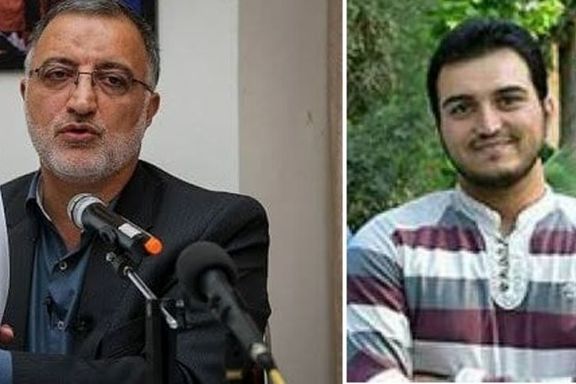
The Tehran City Council has grown weary of repeated interference in decision-making processes by the mayor's son-in-law, who holds no official position.
Ali-Asghar Ghaemi, a member of the Tehran City Islamic Council, stated on Sunday that an official warning has been drafted and signed by nine council members to address the issue, and it will soon be presented to the council's executive board.
The Islamic City Council of Tehran oversees the governance of the city, including the election of the mayor and the allocation of budgets for the Municipality of Tehran. Its 21 members are elected through a plurality-at-large voting system for four-year terms.
Ghaemi noted, "The interventions by [Mayor Alireza] Zakani's son-in-law in various entities and subsidiary public companies of Tehran Municipality have reached a point where even the authority to make seemingly simple decisions has been stripped away from the managers."
Alireza Zakani, the hardliner mayor of Tehran, had appointed his son-in-law, Hossein Haydari, as his advisor, while Haydari concurrently served as the head of the board of directors for a holding company responsible for the information technology of Shahr Bank (City Bank). Additionally, Haydari and Zakani’s daughter hold managerial roles in several other IT companies working with Iran's phone and internet service providers.
In response to public outcry over the mayor's nepotism, Zakani initially said that Haydari was intended to work for free, and later announced that he had rescinded Haydari's advisory position.
"The decision to revoke the advisory role for Zakani's son-in-law was commendable; nevertheless, it was expected that this action would be put into practice," Ghaemi added.
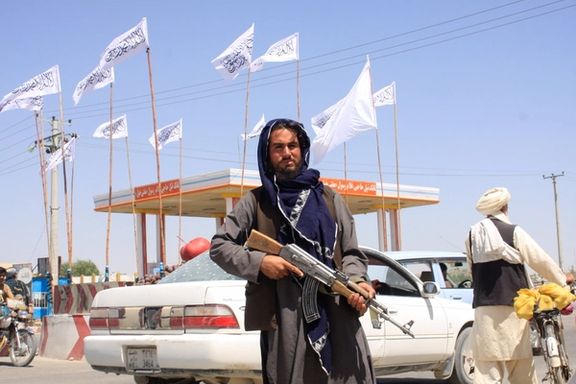
A newspaper affiliated with Iran's Revolutionary Guard has praised the Taliban in Afghanistan, mentioning the withdrawal of US troops as its main achievement.
The Javan newspaper highlighted several aspects, including the "withdrawal of US forces, ensuring political and security stability, increasing transparency, and reducing corruption," as positive aspects of the Taliban's governance.
On the occasion of the second anniversary of the Taliban returning to power, the newspaper stated that "despite the decline in support and financial aid [to Afghanistan] from the United States and NATO, the Taliban has successfully maintained the security, political, and economic structures of the country over the past two years."
Javan's article stated, "Corruption has diminished, and Afghanistan's position on the global transparency index has improved."
The IRGC outlet declared the most significant Taliban accomplishment was "the withdrawal of US and NATO forces" from Afghanistan. It also claimed that curbing the activities of Islamic State – Khorasan Province (ISIS-K), an affiliate of ISIS operating in Afghanistan, Pakistan, Tajikistan, and Uzbekistan, was another achievement.
Furthermore, the report acknowledged the suppression of armed resistance led by Ahmad Massoud, the leader of the National Resistance Front of Afghanistan, as an achievement during the past two years of Taliban rule.
Nonetheless, the paper also acknowledged shortcomings during the two years of Taliban rule, such as strict measures against girls and women, restrictions on ethnic and religious minorities, and an "imbalanced foreign policy," particularly a hopeful stance towards the US.
Earlier in the week, Fars News Agency – another IRGC-affiliated media outlet -- strongly objected to a tweet by Iran’s foreign minister criticizing the Taliban, alleging that it could have adverse consequences for bilateral ties.
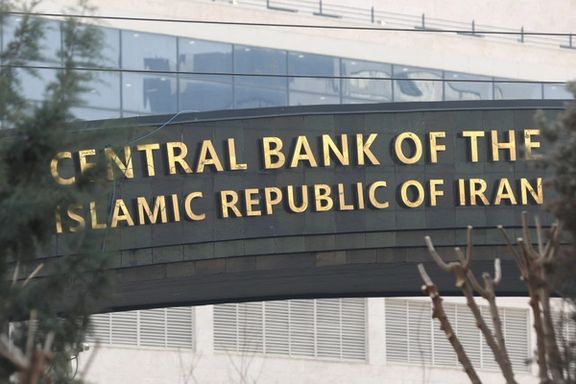
The unblocking of Tehran’s frozen funds after a hostage release deal with the United States has led to internal political debates and recriminations in Iran.
The former Central Bank governor has criticized the government’s claim of freeing $6b without a new nuclear deal or accession to the anti-money-laundering watchdog, FATF’s rules.
“Should we now rejoice for using our resources for food and medicine with America’s permission? Is this neutralization of [US] sanctions? Why don’t you say that we have been deprived of $6b in oil income every two months, a total of $72b, during [past] two years?” Abdolnaser Hemmati asked the government in a post Saturday on Twitter which has now been rebranded as X. He was referring to incessant opposition by hardliners to resolving differences with the United States in the past several years. The same hardliners now control Iran’s government.
They have continued to gloat about the government’s “achievement” and the Tehran Municipality-owned Hamshahri newspaper, which is now controlled by hardliners, has admitted that dual citizens were indeed taken hostage to force the United States to unfreeze Iran's frozen assets.
The reformist Ham-Mihan newspaper also argued the $6b that Iran will be able to use will not “undo any major knots in the country’s circumstances” because reducing the risk of foreign investment in Iran would have been a much more important factor in improving the country.

In a series of other posts Friday, Hemmati also argued that US sanction are still in place and any agreement with the US outside the framework of the 2015 nuclear deal, which has become obsolete in the past two years, does not change it. He also said the criticism against the government remains valid for dragging the process so much and returning to the starting point after two years of losses incurred by the country.
“Why did you circumvent Europe and resorted to [the mediation of] regional countries? More importantly, why you couldn’t implement the JCPOA or achieve a better deal to remove the sanctions despite claiming to be a mighty government?” he asked.
“Confirmed: One billion of the $7b [of frozen assets in South Korea is gone!” Mostafa Faghihi, the managing editor of the moderate conservative Entekhab news website said in an X post. “Can you see how the Iranian nation’s assets are being squandered as a result of the glorification of these gentlemen and theoreticians of ‘resistance against sanctions until the death of others’?”
Governor of the Central Bank of Iran, Mohammad Farzin, has admitted that the Iranian money held by South Korean banks has lost around $1b of its value in the past five years due to the devaluation of Won against the dollar during this period.
Faghihi, too, criticized the government for claiming that its foreign policy is “dignified” although they have agreed to have the approval of the United States for spending every cent of the unfrozen assets which should only be used for food and medicine.
Nizar Zakka, a Lebanese businessman who spent about four years in prison in Iran, however, told Iran International that his sources believe Iran will be receiving over $10 billion as part of the deal with the US to be spent exclusively for humanitarian purposes.
Iran’s funds are mostly kept in banks in South Korea ($7 billion), Iraq ($11 billion), Japan ($3 billion) as well as China and India where Iran is owed for shipments of crude and other oil products before 2018 when the United States pulled out of the JCPOA nuclear deal and re-imposed sanctions on Tehran.
In the past few years Iran has arrested several dual citizens on trumped up charges of spying for the US or European countries, in effect using them as hostages to extract concessions.
Security forces’ arrest of dual citizens, that is hostage-taking, was a display of Iran's great intelligence capability which “forces the enemy to unfreeze Iran's blocked assets,” a commentary published in a newspaper’s front-page Saturday claimed.
Zakka, who is the president of Hostage Aid Worldwide -- an NGO to support and help the release of people held hostage for unjust reasons – said his organization hopes that the prisoner swap deal will put an end to the “hostage business model” that the Islamic Republic has been conducting.
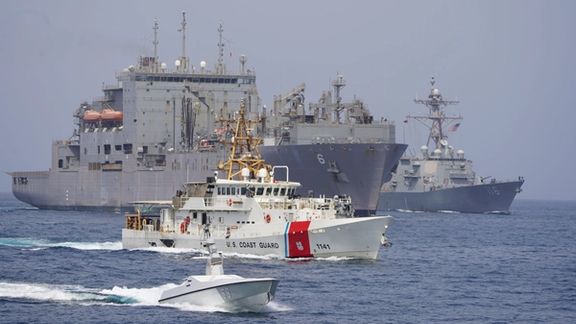
Days after a hostage deal freeing $6 billion in Iranian funds, the US Navy has warned ships in the Persian Gulf to stay away from Iran’s waters to avoid possible seizure.
The stark warning shows tensions remain high in and around the Strait of Hormuz, where Iran seized tankers in late April and early May, while Washington and Tehran are implementing a deal to free five US citizens held hostage in Iran and the US allowing $6 billion in Iranian funds held in South Korea to be unfrozen. The US Navy has warned in recent weeks that the Islamic Republic staged more than 15 attacks and seizures of vessels in the past two years.
"The International Maritime Security Construct is notifying regional mariners of appropriate precautions to minimize the risk of seizure based on current regional tensions, which we seek to de-escalate," Commander Timothy Hawkins, spokesman for the Bahrain-based US Fifth Fleet, said late on Saturday.
"Vessels are being advised to transit as far away from Iranian territorial waters as possible."

The warning also shows that Washington has little trust in Tehran’s intentions, even though they have secretly negotiated the latest deal. Some sources say that the agreement goes beyond freeing the hostages, and the United States will agree to the release of all Iranian funds frozen abroad, including in Iraq ($11 billion) and Japan ($3billion) in exchange for Tehran agreeing not to enrich uranium beyond 60-percent purity. Tehran is said to have already accumulated enough enriched uranium for producing at least two nuclear bombs.
The Biden administration has been beefing up US forces in the Persian Gulf region for weeks, deploying F-16 and F-35 warplanes, additional naval vessels, and Marines, as it has been working on the deal with Iran. The US on August 1 offered to provide armed troops to commercial vessels transiting the Strait of Hormuz, a narrow waterway where it is difficult to stay far away from Iran’s territorial waters.
Iran has also been putting up a show of force in recent weeks. The Islamic Revolutionary Guard (IRGC) held drills around three Iranian islands in the Persian Gulf contested by the United Arab Emirates, and claimed that it has added a 600-kilometer-range new missile to its arsenal “for defending the islands’ territory.”
Hossein Salami the commander of the IRGC delivered another speech on August 5, praising what he called unprecedented advances the Islamic Republic has made in naval power. In typical veiled language Salami said that “the enemy’s presence instead of posing a threat became an opportunity…and we expanded our defense and military” capabilities.
About a fifth of the world's crude oil and oil products pass through the Strait of Hormuz, a choke point between Iran and Oman at the mouth of the Persian Gulf.
If reports about a larger unwritten deal between Tehran and Washington, including issues other than hostages are true, it will come at an opportune moment for political leaders in both countries.
Some believe that President Joe Biden wants to reduce the likelihood of incidents and tensions with Tehran, especially a nuclear breakout before his re-election bid next year. Iranian hardliners who control the government, face serious economic and political challenges at home. Renewed mass protests and deteriorating economic conditions have left them with little choice but to negotiate for terms that would offer them some financial relief.

Iranians held a demonstration in the northwestern city of Tabriz on Saturday to protest mismanagement that has led to the disappearance of Lake Urmia.
The protesters gathered outside the provincial office of Iran’s Natural Resources and Watershed Management Organization, demanding the reopening of dams on rivers that feed the lake to resuscitate the dying hypersaline body of water.
Located between the provinces of East Azarbaijan and West Azarbaijan in northwestern Iran, Lake Urmia (Orumiyeh) was the largest lake in the Middle East and the sixth-largest saltwater lake on Earth with an original surface area of 5,200 square kilometers in the 1970s, or 2,000 square miles. It had shrunk to 700 sq km by 2013. The lake began shrinking in the 1980s due to water mismanagement and climate change.
During the demonstration, people chanted slogans such as "Lake Urmia is thirsty" and "Break the dams, fill Lake Urmia." In July 2022, a protest was also held and police arrested an unknown number of activists.
Once a thriving tourist hotspot with bustling hotels lining its shores and commercial ferries plying its waters, the lake currently hovers on the brink of utter disappearance. This dire situation is the result of a combination of factors, including prolonged droughts, excessive water consumption by local communities, and the ill-conceived construction of dams along its tributaries, all exacerbated by the regime's neglectful approach.
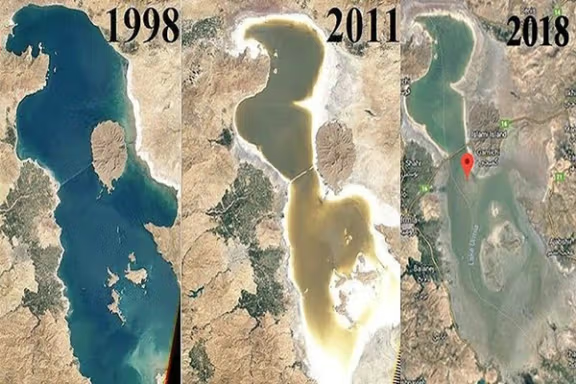
Experts say excessive and illegal groundwater extraction and using the water of the once bountiful Zarrineh Rud − which feeds Urmia Lake − for irrigating apple trees have both contributed to the lake shrinking by nearly 95 percent in volume over the past 20 years. In 2021 alone, more than 100,000 tons of apples of the province’s production went to waste.
Recent images capturing the last gasps of the lake depict a stark portrayal of its complete extinction and the severe environmental repercussions in the region. Nevertheless, regime officials still defend their actions with several phantasmagorical visions.
Ali Salajegheh, a vice president and the head of Iran's Department of Environment Protection, said during his visit to the region that “We hope that with substantial autumn rainfall, the situation of Lake Urmia will improve.”
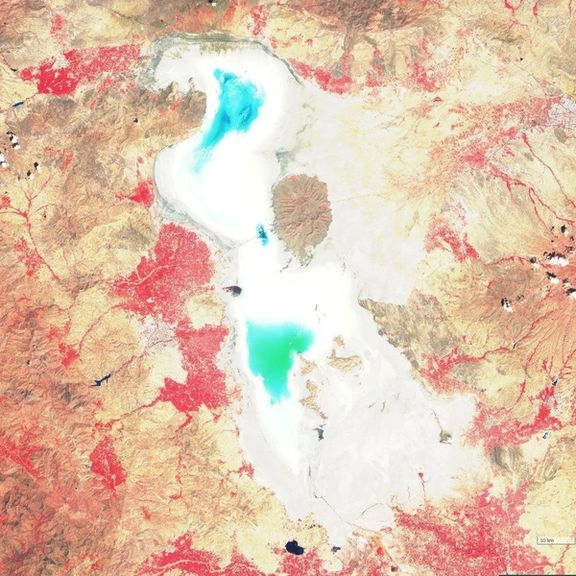
His claims came a day after Ramezan Sharif, the spokesperson of the Islamic Revolutionary Guard Corps (IRGC), described the public concern over the dying lake as an attempt by the critics of the regime to "undermine the authority of the Islamic Republic.” He claimed that "over the past 800 years, several lakes like Lake Urmia have dried up around the world, and these specific climate changes are not unique to Iran."
Fars news agency, affiliated with the Revolutionary Guard, quoted Salman Zaker – representative of the city of Orumiyeh in the parliament -- as saying on Saturday that the private sector can play a constructive role in saving the lake. "This is a demand shared by the public at large, and the government should engage the private sector in this endeavor. Thousands of residents of the region are eager to contribute to saving Lake Urmia by participating in the water transfer project from the Caspian Sea,” he said.
His remarks showed the attitude of regime insiders who make grandiose and baseless statements. Transferring water from the Caspian Sea hundreds of kilometers away would be a herculean task.

“Approximately 28 solutions have been considered for the revival of Lake Urmia," he said, claiming that “The results of the measures taken to revive Lake Urmia may not yet be tangibly evident... However, these actions can gradually lead to positive outcomes for the lake.”
Etemad, one of Tehran's prominent reformist dailies, said in an opinion piece on Saturday that studies indicate even the release of water from all upstream dams cannot revive Lake Urmia. Citing a study by researchers at Tehran’s Sharif University, the article said, "The water level of Lake Urmia on June 3, 2023, reached its lowest recorded level since measurements began, and now the volume of water is even lower than in 2015, the year when the lake's condition was announced as critical.”
In May, the former head of Iran's Environment Protection Organization warned that four million Iranians risk displacement if Lake Urmia dries up. “Transferring the residents of Tabriz to another place requires $500 billion while the cost of reviving the lake is about one billion dollars,” Issa Kalantari said, explaining that the salt dust would be unbearable for residents in Tabriz and its surrounding cities.
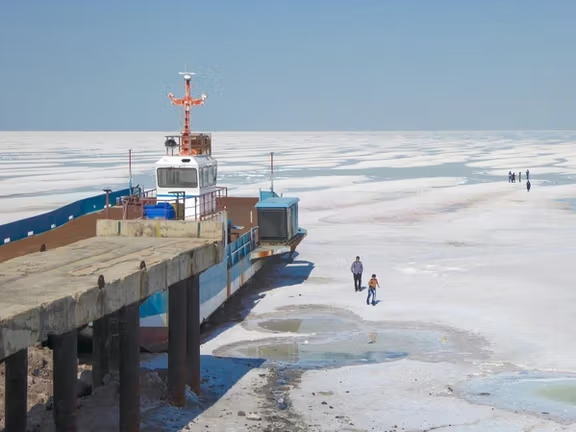
Last year, when the lake had shrunk by 95 percent, he said the fate of the Iranian regime is contingent on saving the lake. If the lake is not restored, it will have security consequences, and no government can survive in the country because it cannot withstand the flood of migration of millions of people who reside in the surrounding regions, he said.
The government of President Hassan Rouhani appropriated 150 trillion rials – in 2014 – equivalent to one billion dollars at the time - for a seven-year plan as well as another $10 million aid by Japan and some other pledges by the United Nations Food and Agriculture Organization (FAO) and the United Nations Development Program (UNDP) to save the lake. It is not clear whether or how the earmarked budgets were spent.